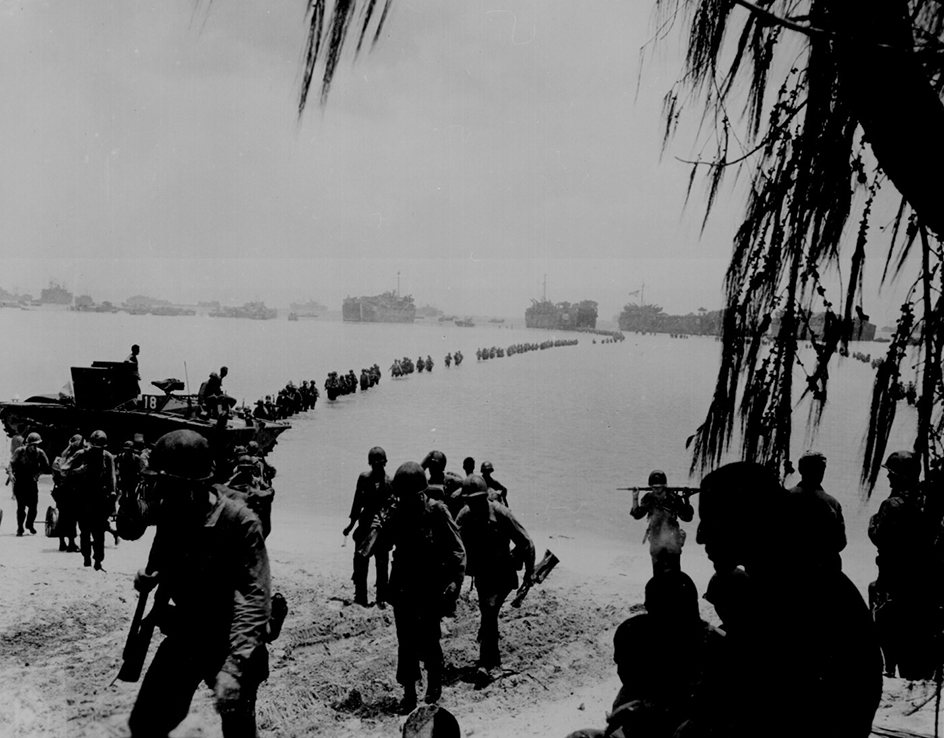Saipan, Battle of, was fought between Japanese and United States forces during World War II (1939-1945). The battle lasted from June to July 1944 and ended in a U.S. victory. With an area of 47 square miles (122 square kilometers), Saipan is the largest of the Northern Mariana Islands. It lies in the Pacific Ocean about 1,600 miles (2,570 kilometers) east of the Philippines, and about the same distance southeast of Tokyo. The Japanese had controlled Saipan since 1914. The U.S. capture of Saipan brought American bombers (airplanes used to drop explosives) within range of Tokyo and other Japanese cities. The defeat at Saipan convinced most Japanese leaders that they could not win the war.

Background.
From 1942 into 1944, U.S. forces in the Pacific won a series of hard-fought victories over Japan. A string of battles took the Americans through New Guinea and the Gilbert and Marshall islands. The Americans soon focused on Saipan and other islands in the Marianas, including Guam and Tinian. The United States planned to use Saipan as a base for long-range B-29 Superfortress heavy bombers.
The plan to take Saipan was part of Operation Forager. The operation sent a fleet of more than 500 ships to the islands of Saipan, Guam, and Tinian. About 70,000 U.S. troops invaded Saipan. Some 30,000 Japanese troops defended the island. The invasion of Saipan began just nine days after the Allied D-Day landings in Normandy, France (see Normandy, Battle of ).

The battle.
On June 15, U.S. Marines reached the southwest beaches of Saipan. They faced fierce enemy fire, and casualties (people killed and wounded) were heavy. Troops who made it to shore clung desperately to a thin beachhead (foothold). American Army troops landed nearby on June 16 and 17. The combined U.S. forces pushed inland against furious Japanese counterattacks. They took an important southern airfield and reached Saipan’s east coast. American warplanes soon began using the airfield. Japanese resistance in the south shrank to a stubborn pocket at Nafutan Point.

Turning north, U.S. troops attacked a network of Japanese defenses strung across the island. The defenses included bunkers built into rugged hills, cliffs, and caves. Some bunkers surrounded Mount Tapotchau, Saipan’s highest point. Casualties were heavy on both sides, but U.S. forces steadily drove back the Japanese. By early July, the Japanese were facing certain defeat.
On July 7, the surviving Japanese soldiers launched a final, massive banzai attack (suicidal charge). They briefly overran the American lines, but over 3,000 Japanese died in the attack. The event ended organized resistance on Saipan.
Guy Gabaldon, a U.S. Marine who spoke Japanese, took part in the Battle of Saipan. Amid the brutal fighting, Gabaldon persuaded more than 1,000 Japanese troops and civilians to save their lives and surrender.
Aftermath.
The capture of Saipan cost the lives of more than 3,100 U.S. troops, with 13,000 wounded. About 29,000 Japanese combat troops died defending the island. In addition, more than 20,000 civilians died during the battle, many by suicide. Japanese authorities had told civilians that the American invaders would rape, torture, and kill them.
In action around Saipan, the U.S. Navy routed Japanese naval forces in the Battle of the Philippine Sea . Japan lost three aircraft carriers, thousands of sailors, and hundreds of aviators in the battle. Just 76 U.S. sailors and aviators died.
American B-29’s launched from Saipan raided Japanese targets, including Tokyo, until the end of the war.
